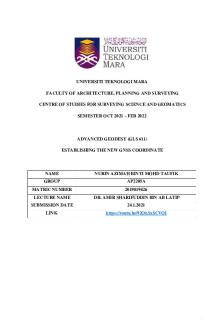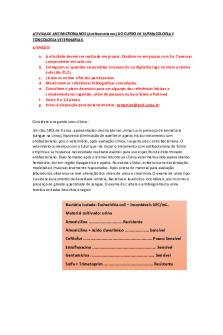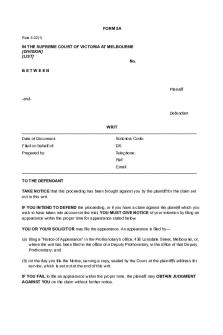AP220 5A GNSS Report PDF

| Title | AP220 5A GNSS Report |
|---|---|
| Course | Science Geomatics |
| Institution | Universiti Teknologi MARA |
| Pages | 34 |
| File Size | 2.8 MB |
| File Type | |
| Total Downloads | 347 |
| Total Views | 795 |
Summary
UNIVERSITI TEKNOLOGI MARAFACULTY OF ARCHITECTURE, PLANNING AND SURVEYINGCENTRE OF STUDIES FOR SURVEYING SCIENCE AND GEOMATICSSEMESTER OCT 2021 – FEB 2022ADVANCED GEODESY (GLS 611)ESTABLISHING THE NEW GNSS COORDINATENAME NURIN AZIMAH BINTI MOHD TAUFIKGROUP AP2205AMATRIC NUMBER 2019819826LECTURE NAME ...
Description
UNIVERSITI TEKNOLOGI MARA FACULTY OF ARCHITECTURE, PLANNING AND SURVEYING CENTRE OF STUDIES FOR SURVEYING SCIENCE AND GEOMATICS SEMESTER OCT 2021 – FEB 2022
ADVANCED GEODESY (GLS 611) ESTABLISHING THE NEW GNSS COORDINATE
NAME
NURIN AZIMAH BINTI MOHD TAUFIK
GROUP
AP2205A
MATRIC NUMBER
2019819826
LECTURE NAME
DR. AMIR SHARIFUDDIN BIN AB LATIP
SUBMISSION DATE
24.1.2021
LINK
https://youtu.be/92OhSxSCVQI
EXECUTIVE SUMMARY The Global Navigation Satellite System (GNSS) is a constellation of satellites that transmits location and timing data to GNSS receivers via space signals. This information is subsequently used by the receivers to establish their location. GNSS, by definition, gives worldwide coverage. The Galileo navigation satellite system in Europe, the NAVSTAR Global Positioning System (GPS) in the United States, the Global'naya Navigatsionnaya Sputnikovaya Sistema (GLONASS) in Russia, and China's BeiDou Navigation Satellite System are all examples of GNSS. Four criteria are used to evaluate GNSS performance: Accuracy: the difference between a receiver’s measured and real position, speed or time Integrity: a system’s capacity to provide a threshold of confidence and, in the event of an anomaly in the positioning data, an alarm Continuity: a system’s ability to function without interruption Availability: the percentage of time a signal fulfils the above accuracy, integrity and continuity criteria. Land surveying usually relies on geodetic control networks that will be used as reference points and surveys are made in relation to these reference points. The use of GNSS allows for precise location of coordinates on a global reference frame, and GNSS land surveying instruments produce measurements that are independent of what happens to the surrounding land, structures, or landmarks. The observations data must first be processed using any associated software like as RTKLIB and Trimble Business Center to acquire the most precise and dependable sets of data.
TABLE OF CONTENT Executive Summary Introduction
1
Aim and Objective
1
Methodology
1 - 13
Result and Analysis
14 - 29
Conclusion
30
Individual comment
30
Reference
INTRODUCTION The Global Navigation Satellite System (GNSS) is used to establish precise locations all over the world, in all weather conditions and at all times of the day. In comparison to traditional surveying approaches, GNSS geodetic surveying equipment has gotten smaller and easier to use. Large topographic surveys that require centimetre-level accuracy are best served by GNSS. AIM AND OBJECTIVE The aim of this task is we want to achieve and establish high accuracy data to create the GNSS control point. There are several objective in this task that we are looking for: • To configure the GNSS software • To create GNSS control network design. • To conduct observations and process all data to establish high accuracy of GNSS control point. • To analyse the accuracy and precision of quality satellite data • To analysis the GNSS processing result. METHODOLOGY Software Software used for this task: RTK LIB, Leica Spider QC and Trimble Business Center (TBC) Study Area This Survey are held on 12 different places because from the formula n=13-1=12, which is: Fixed Point • AYER • BAND • LASA • GET2 1
• KRAI • SIK1 New Point • PTK01 • S1081 • S0293 • S0392E • S1067 • S0317 Pre-processing Pre-processing is an important step in determining the most appropriate data observation for post-processing. To ensure that the data is reliable and can be used for further processing, many conditions must be met. RTKLIB v2.4.2 and Leica Spider QC is the software utilised at this stage for the quality checking. i. Quality checking using RTKLIB software The following conditions must be met in order for the observation data to be reliable:
The satellite activity must be equal to or greater than 8 hours; this shows whether the satellites are active or not. At this point, we can also determine whether or not the data obtained from satellites is available.
We looked at the SkyPlot of the data after establishing that the satellites were operating. The info must flow smoothly across the viewer's quadrant of presents. The data's DOP value will then be determined. The DOP value should not exceed 6.
The data's multipath error will then be determined. The thresholds differ according to the receiver. The thresholds for the Leica G25 receiver, for example, are 0.5.
2
Procedure of RTKLIB 1. Open RTKLIB and import the observation data into RTKPLOT. 2. Figure below shows the satellite visualization of Ayer, the line green and blue represent the data being obtain from the satellite. The minimum length of period for the observation must not exceed less than eight (8) hours because if it is less than that, the data will be considered as non-reliable data.
3. We can also change from the satellite visualisation to satellite SkyPlot. From the RTKLIB, we can also see know the multipath and the thresholds to achieve the most optimum result which is less than 0.5m.
3
Figure above hows the satellite SkyPlot of Ayer
Figure above shows the multipath of observation data for Ayer. We can see the threshold is less than 0.5. 4. After that, we can import the DOP data and the multipath data from the observation and from the data we will see all the DOP is less than 6. As for the multipath value we need to make sure the data does not exceed 0.5. 5. The step is being repeated for all the RINEX Data, CORS L9 and LOOP 9. ii. Quality checking using Leica Spider QC As for this process, I import all the RINEX data and process the data for the quality checking. In here, I checked the data whether it is failed or pass for the quality testing, how many cycle slips that the data has obtained, the multipath, data of completeness, PDOP and GDOP. All the data is being tabulated.
4
BASELINE PROCESSING 1. After the pre-processing, we proceed to the baseline processing of each data that we have obtained. Before carrying out the baseline processing, there are several settings or parameters that must be set depends on the specification of our work. For this process, we need to go to the project setting before proceed to other work.
2. Decimal places for the latitude is 5 decimal places, for coordinates and elevation is 3 decimal places only.
5
As for the quality under baseline processing in the project setting, I had changed the new acceptance citeria of horizontal and vertical precision. This will be the tolerance for this task. If the data is under the limitation, yellow flag is appeared and if the data exceeded the tolerance, the red flag is appeared. The flag that pop-up at the line is indicate that the line is failed.
6
3. Below is the view aftter I have doen the baseline processing.
4. After that, go to the session editor and me chose GET2-LASA baseline for the process of removing cycle slips. - highlight (cycle slips) the choosing satellite to do comparison before and after. In these cases, I choose G3. After highlight, click OK. Below is the difference before and after session editor for GET2-LASA.
Before session editor
The figure above depicts GNSS statement information that includes sounds that must be eliminated. The information gathered through the base is shown by the blue line, while the information gathered through the rover is represented by the green line.
7
After session editor
One of example to edit the GNSS data and to remove the noise contain in the data. INDEPENDENCE BASELINE PROCESSING 1. All the data of CORS L9 and LOOP9 is imported to the TBC for the independence baseline processing.
8
2. Below is the table of station that I used for the independence baseline processing. There will be six session that include the data from the CORS L9 and LOOP 9 data for each session. The time for each session must cover the 24 hours time. The shortest line is chosen and it must have 13 points and 12 baseline.
9
3. Start to follow baseline that I already created per session. The time is set to 10/2/2020 12:40:00 to 10/2/2020 16:40:00 and the duration is 4 hours for each session. Then Export it using TDEC format file. Below is the example of my session 2 station line. In addition, must export the PP vector in asc file.
10
4. The same step is being repeated for other five session.
11
NETWORK ADJUSTMENT 1. First, we need to import the asc file that we saved for each session from the independence baseline processing.
2. Fixed the two coordinate from the data that been imported into the TBC. For this task, I choose SIK1 and KRAI. Below is the image I do for the fixed coordinate at the corstation for SIK1. The coordinate type is global and for the latitude, longitude and height I followed the coordinate of corstation that been retrieved from the SpiderWeb website.
12
2. The same process is being repeated for KRAI. 3. After the two coordinate is fixed, the network adjustment can be carried out. In here, I choose 2d and h for constraint and adjust it.
4. Below shows the result after some adjustment The Results will show reference factor, Chi Square test, and degree of freedom. In this case, the chi square test is passed.
5. The result of the adjusted coordinate is produced in the network adjustment report. 13
RESULT AND ANALYSIS RTKLIB CORS L9
AYER
BAND
14
GET
KRAI
LASA
15
MUSA
SIK
16
LOOP 9
PTK10410 – PORT KLANG
S0392E - ESENTRIC DI ATAS TANDA SEMPADAN KELANTAN-PERAK
17
S0293 KLINIK DESA SUMPITAN,LENGGONG
S0317 - PEJ. RENJER HUTAN,JELI
18
S1067- (KLINIK KESIHATAN DABONG) LOOP9
S1081 – GERIK
19
LEICA SPIDER QC SOFTWARE
CORS L9
LOOP 9
20
Based on the pre-processing results, I can conclude that observation data LASA and BAND is the most reliable observation data than other data as it contains the most active satellites activity, have good DOP and multipath. To conclude, PDOP value with the value below 6 were good and if the value below 4 were great. Value at 9 or higher meant that the user shouldn’t rely on the accuracy of data and should wait until a better PDOP value could into perfect positioning. The average observation time is 24 hours for all of data. From the data also, we can see all Loop 9 data Fail in cycle slips, multipath and data completeness and 4 of Cors L9 data fails because of cycle slip. BASELINE PROCESSING
21
22
23
24
As the baseline processing report, there is yellow flag that appeared on the result. The yellow falg indicate that the data is under the limitation
25
NETWORK ADJUSTMENT REPORT
26
The reference factor that I got after doing the network adjustment is 0.94 and thus, the chi-square feet is passed.
27
DETERMINING THE NEW ESTABLISHED COORDINATE
28
By doing this differential, we can see that station MUSA has the most red flag and that indicate that MUSA a very bad line. Other stations do have a good conditions of line than MUSA. Only at the second value of latitude and longitude is there a mismatch between the process station and known coordinates. This point is extremely good when repairing AYER, BAND, GET2, and LASA because there is no flag and the baseline processing result is still in good condition. Meanwhile, all of MUSA's lines have red flags, and the ellipsoidal height data is more than 1.0. All lines in SIK1 are tolerable, but tolerance for ellipsoidal height and longitude value is not allowed in SIK1 to KRAI and MUSA (vertical).
29
CONCLUSION In conclusion, if we want to obtain new coordinate and location for GNSS, we need to ensure every single parameters and criteria is followed. This is because without proper procedure or the quality control, it resulted into disastrous for the positions of the country. In this task, I can say that, we can improve the quality of the data using software such as RTKLIB and Leica SpiderQC. This software helps a lot in determination of each data and give the visualization result whether the data followed the tolerance. Other than that, I can learn and know the processing flow that we need to established new coordinate such as baseline processing, network adjustment, dependent and independent baseline. INDIVIDUAL COMMENT I want to say thank you to Dr Amir and my friends that already helping me in finishing my lab report. It is very hard to understand at first but with the help from Dr Amir and my friends, I able to understand the flow of this task. In doing this task, I learnt many things such as the tolerance of the multipath which need to be below than six, the tolerance of reference factor in network adjustment and Mny other things. Overall, I can say that I really enjoyed doing this task even there are many obstacles that came and I want to say sorry to Dr Amir if my video do have many flaws.
30
REFERENCE 1. PKPUP Bil 2/2008 Garis Panduan mengenai system rujukan koordinat di dalam penggunaan GNSS bagi tujuan Ukur dan pemetaan 2. PKPUP Bil 6/1999 Garis panduan pengukuran menggunakan alat system penentududukan sejagar (GPS) bagi ukuran kawalan kadaster dan ukuran kadaster 3. PKPUP Bil 1/2008 Garis panduan mengenai ujian alat GNSS yang menggunakan perkhidmatan Malaysian RTK GNSS network (MYRTKNet) 4. Lab class video
31...
Similar Free PDFs

AP220 5A GNSS Report
- 34 Pages

643R35 Antena GNSS Bodet
- 2 Pages

Solutionmanual 5a
- 42 Pages

Practica 5a
- 8 Pages

Caso clínico 5A-2
- 2 Pages

Form 5a writ template
- 4 Pages

Support EX19 5a Locations
- 4 Pages

5A Lecture 24 - samani
- 2 Pages

Proteinbestimmung Fluorometrie 5A-3
- 16 Pages

5A Lecture 22 - samani
- 2 Pages

5A. Valoración de Acciones
- 11 Pages

Photometrie Spektroskopie 5A-3
- 16 Pages

Sozialstruktur Vorlesung 5a
- 3 Pages

Stats Assignment 5A
- 11 Pages
Popular Institutions
- Tinajero National High School - Annex
- Politeknik Caltex Riau
- Yokohama City University
- SGT University
- University of Al-Qadisiyah
- Divine Word College of Vigan
- Techniek College Rotterdam
- Universidade de Santiago
- Universiti Teknologi MARA Cawangan Johor Kampus Pasir Gudang
- Poltekkes Kemenkes Yogyakarta
- Baguio City National High School
- Colegio san marcos
- preparatoria uno
- Centro de Bachillerato Tecnológico Industrial y de Servicios No. 107
- Dalian Maritime University
- Quang Trung Secondary School
- Colegio Tecnológico en Informática
- Corporación Regional de Educación Superior
- Grupo CEDVA
- Dar Al Uloom University
- Centro de Estudios Preuniversitarios de la Universidad Nacional de Ingeniería
- 上智大学
- Aakash International School, Nuna Majara
- San Felipe Neri Catholic School
- Kang Chiao International School - New Taipei City
- Misamis Occidental National High School
- Institución Educativa Escuela Normal Juan Ladrilleros
- Kolehiyo ng Pantukan
- Batanes State College
- Instituto Continental
- Sekolah Menengah Kejuruan Kesehatan Kaltara (Tarakan)
- Colegio de La Inmaculada Concepcion - Cebu

